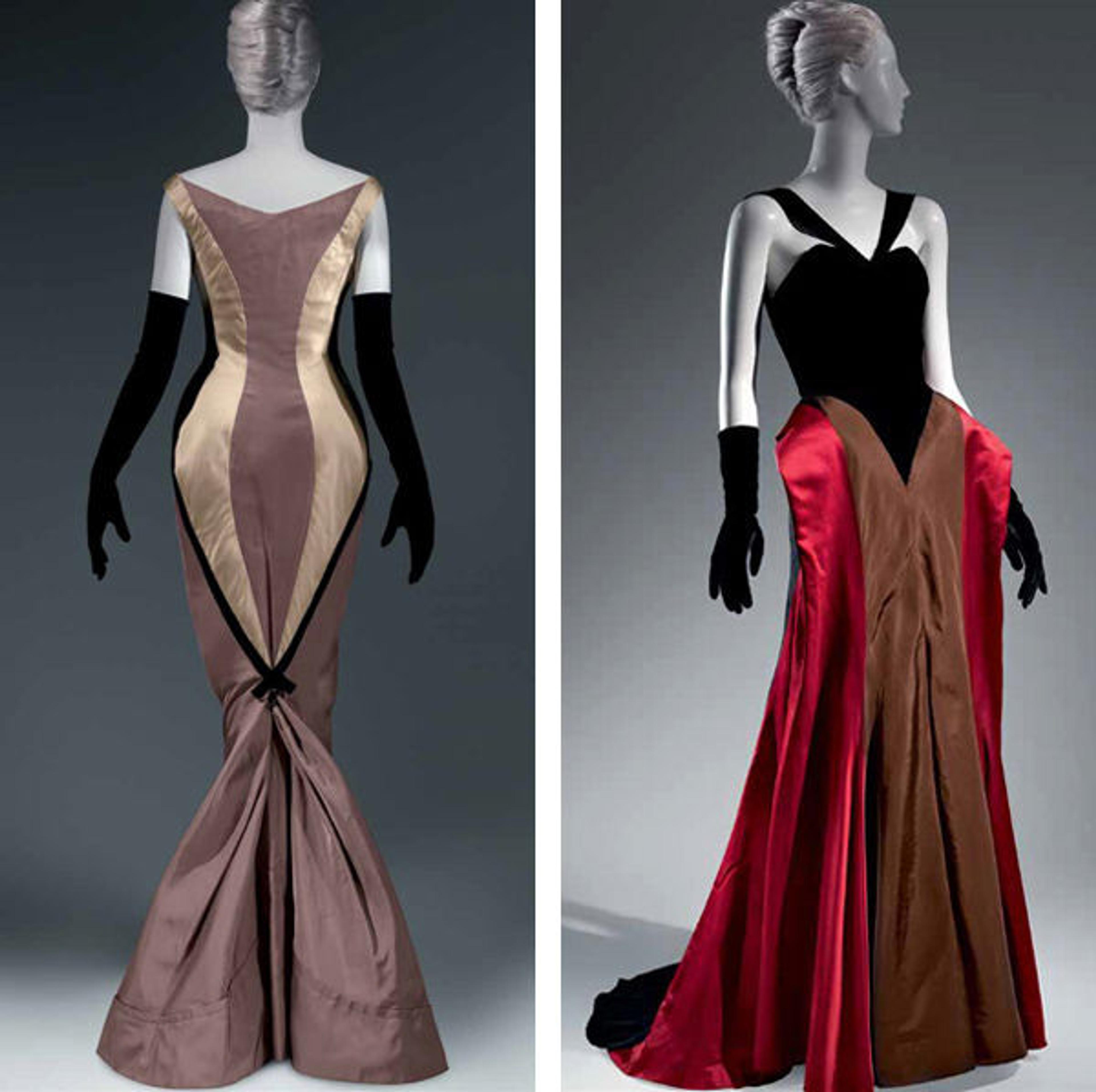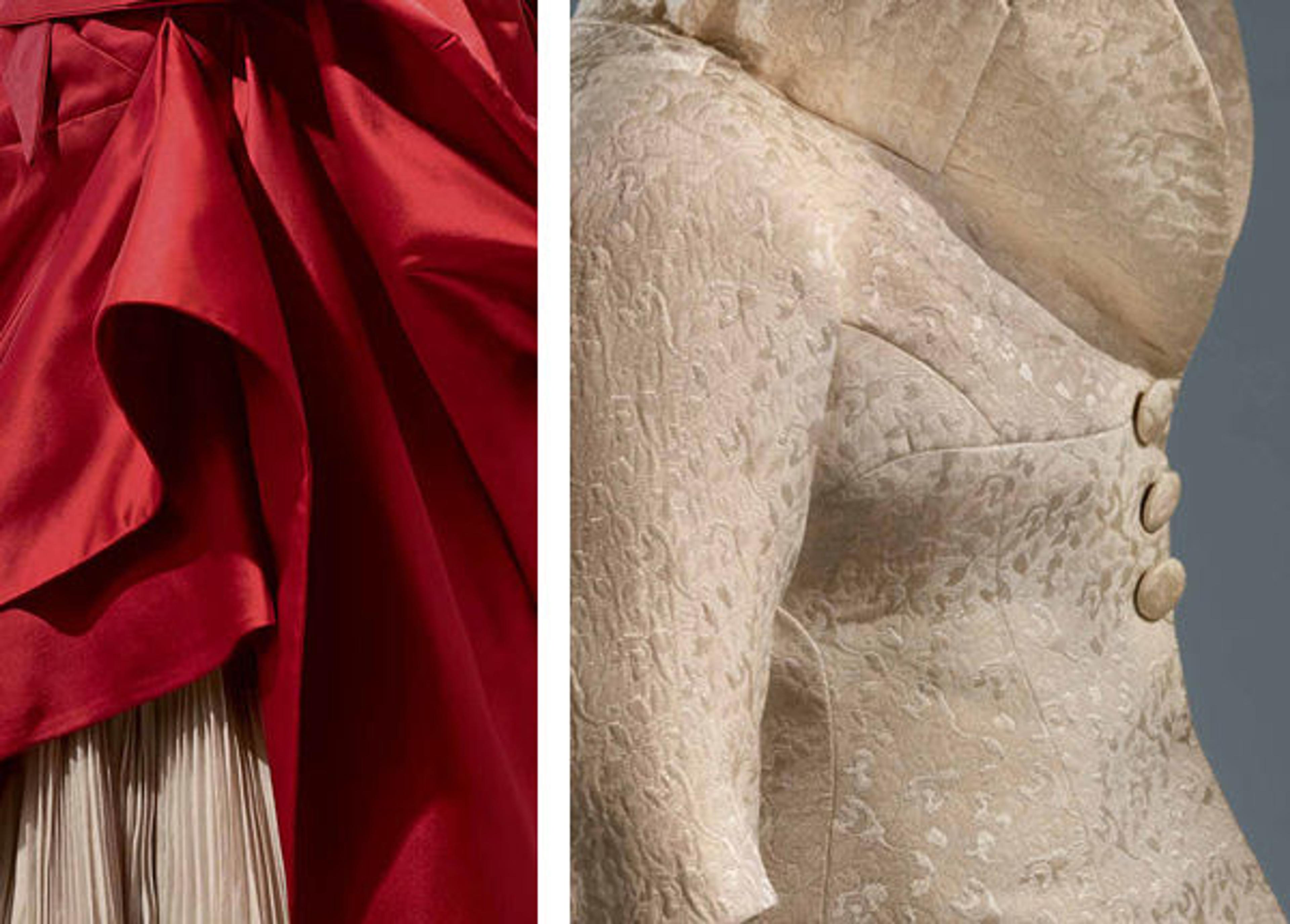Charles James: Beyond Fashion—Interview with Photographer Karin L. Willis

Left: Charles James (American, born Great Britain, 1906–1978). "Diamond" Evening Dress, 1957. Ivory silk satin, beige silk twill, and black rayon velvet. The Metropolitan Museum of Art, New York, Brooklyn Museum Costume Collection at The Metropolitan Museum of Art, Gift of the Brooklyn Museum, 2009; Gift of Maguerite Piazza, 1984 (2009.300.1015a, b). Right: Charles James (American, born Great Britain, 1906–1978). Evening Dress, 1946. Black silk-rayon velvet, red silk satin, brown silk faille, and black silk crepe. The Metropolitan Museum of Art, New York, Brooklyn Museum Costume Collection at The Metropolitan Museum of Art, Gift of the Brooklyn Museum, 2009; Gift of Arturo and Paul Peralta-Ramos, 1954 (2009.300.795)
«I recently sat down with Karin L. Willis, the photographer for the Charles James: Beyond Fashion catalogue that accompanies the current exhibition of James's work, on view through August 10. The publication offers a comprehensive study of the life and work of the legendary Anglo-American couturier Charles James (1906−1978), highlights his virtuosity and inventiveness, and includes early photographs and rarely seen archival items—including muslin study pieces, dress forms, and sketches. During our conversation Karin spoke about the challenging but rewarding process of photographing James's designs.»
Rachel High: I previously spoke with Jan Reeder about Charles James's work from a curatorial perspective. How do you approach James's work as an object to be photographed?
Karin Willis: While I'm shooting, my first thought is lighting the objects. The works in this exhibition feature a lot of black, so I needed a lot of light; most of these works had six or seven lights on them. [Exhibition co-curator] Harold Koda also pointed out certain aspects of James's technique, and I shot details showcasing each one. Some of the pieces were wonderful to work with, others less so. We all had our favorites.
Rachel High: Did you have a particular favorite?
Karin Willis: I had a few. I think the "Diamond" Evening Dress is really beautiful but was very difficult to shoot. The Evening Dress from 1946 is a beautiful dress as well, and the "Petal" Evening Stole is extraordinary.

Charles James (American, born Great Britain, 1906–1978). "Petal" Evening Stole, 1956. Black silk-rayon velvet and white silk satin. The Metropolitan Museum of Art, New York, Brooklyn Museum Costume Collection at The Metropolitan Museum of Art, Gift of the Brooklyn Museum, 2009; Gift of Mrs. William Randolph Hearst Jr., 1964 (2009.300.885)
Rachel High: Can you talk about the process of preparing an object for a photo shoot?
Karin Willis: We had to produce three hundred shots in six months, and could only maybe do two a day over the course of a nine- or ten-hour day. It took a while because when a garment was placed on the set, I had to light it and then shoot a three-quarter view or a detail, so none of the lights could stay the same. Everything had to be relit each time somebody moved the object.
The experience allowed me to think on my feet. This book was great to work on because every other minute I was doing something different, which I love. I have been doing this for many years, so a little challenge is nice every now and then. I was even able to pick out many of the compositions for the detail shots. I loved doing the details—I wish I could shoot a whole book of details.

Left: Charles James (American, born Great Britain, 1906–1978). Ball Gown (detail), 1949–50. Red silk velvet and satin and white cotton organdy. The Metropolitan Museum of Art, New York, Brooklyn Museum Costume Collection at The Metropolitan Museum of Art, Gift of the Brooklyn Museum, 2009; Gift of Arturo and Paul Peralta-Ramos, 1954 (2009.300.2786). Right: Charles James (American, born Great Britain, 1906–1978). Dinner Suit (detail), 1956. Ivory rayon-cotton matelassé. The Metropolitan Museum of Art, New York, Brooklyn Museum Costume Collection at The Metropolitan Museum of Art, Gift of the Brooklyn Museum, 2009; Gift of Mrs. John de Menil, 1957 (2009.300.824a, b)
Rachel High: The details in the book really are gorgeous.
Karin Willis: I think they came out well. We did the entire shoot in my studio, which is a little limiting in terms of space. It was a difficult but rewarding project, but we got it done.
Rachel High: What was the most difficult piece to photograph?
Karin Willis: Everything that was black, because the older black fabrics have a brown sheen to them. To keep the fabrics looking black was a great challenge, so, overall, the exhibition was difficult to photograph. I shot in tungsten light since that is a technique that would have been used in Charles James's time, and each dress was lit in a specific manner. When doing such specialized lighting, anything black is a challenge—and anything black and shiny is even harder. Jan's knowledge of James was a great resource during the process, because she knows everything there is to know about these garments.

Charles James (American, born Great Britain, 1906–1978). Evening Dress, 1948. Black silk satin and black silk velvet. The Metropolitan Museum of Art, New York, Brooklyn Museum Costume Collection at The Metropolitan Museum of Art, Gift of the Brooklyn Museum, 2009; Gift of Millicent Huttleston Rogers, 1949 (2009.300.734)
Rachel High: Charles James's work has a strong legacy of being photographed. Former Vogue photographer Cecil Beaton documented many of the dresses during James's time. Can you talk a little bit about this legacy and how it influenced your photography of the dresses?
Karin Willis: To tell you the truth, I had never heard of Charles James before this project. I looked at some books that were shot back in the period, which is why I decided to use tungsten lighting. Many of the pieces had condition issues because James evidently wasn't the most consistent of designers and the lighting was designed to minimize these imperfections, so the gowns themselves influenced the photography in that way. What is amazing to me is that this is the first book focused on James in almost thirty years. It will be interesting to see what kind of visitors go to see it because the older group is going to relate to this a lot more, but I think it will appeal to younger audiences, too. Friends of mine that are designers can't wait to see the exhibition.
Related Links
The Met Store: Charles James: Beyond Fashion
Now at the Met: Interview with Charles James: Beyond Fashion Co-author Jan Glier Reeder
Rachel High
Rachel joined the Publications and Editorial Department in 2014 where she has previously held the roles of Publishing and Marketing Assistant and Assistant for Administration. She manages the MetPublications website, the Museum's text licensing program in all languages, and the @MetPubs Instagram account. In addition to her work marketing The Met's titles, Rachel also consults on Museum co-publications and the Costume Institute catalogues. She has been a speaker at the National Museum Publishing Seminar and is an organizing member of the International Association of Museum Publishers. She holds a B.A. in Art History from New York University and an M.A. in Art History from Hunter College. Her own research centers on the intersections of art and publishing.
Selected publications
“Something Else Press as Publisher.” Master’s thesis, Hunter College, City University of New York, 2020. CUNY Academic Works.